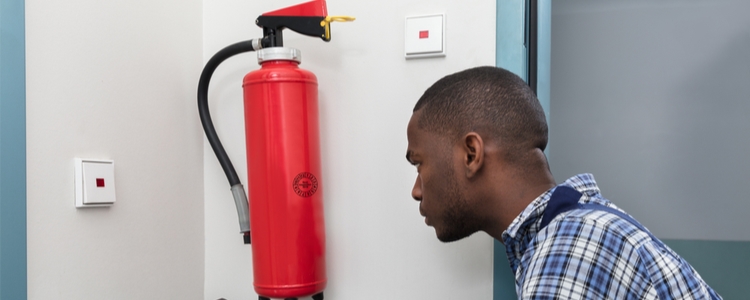Find consumer tips on everything from credit to home safety to travelling on a budget and so much more!
Home Safety Checklist for Daylight Saving Time
While you're updating those manual clocks around the house, don't forget to do your semi-annual household safety checks. Our daylight saving safety checklist can help protect your home and family from preventable accidents.
Inspect Your Fire Extinguishers
- Make sure extinguishers are easily accessible.
- Check the tamper seal and pull pin. If the seal is broken or the pin is missing, replace the extinguisher or have a certified fire extinguisher technician inspect it.
- Look for physical damage and debris in the hoses and nozzles. Replace the extinguisher if it shows signs of damage or corrosion.
- Have fire extinguishers professionally inspected once per year.
Check Your Garage Door Sensors
If they are not working correctly, a closing garage door could harm belongings or people in its path.
- Test the automatic reversing mechanism by placing a piece of wood, such as a 2×4, on the ground in the door's path as it's closing. The door should reverse one or two seconds after hitting the wood. If it does not, refer to your owner's manual on how to make an adjustment to the opener's sensitivity or contact a professional garage door service.
- Test the photoelectric sensors by placing an object in front of them as the door is coming down. The door should immediately reverse. If it does not, check the sensors for alignment, dirty lenses or damage.
Test Your Smoke Alarms
- Push the test button to make sure the alarm sounds.
- See how the alarm responds to smoke: Light a match and blow it out directly under the alarm, or use an aerosol smoke can if the detector is out of reach.
- Have someone stand as far away from the smoke alarm as possible to be sure it's audible.
- Change the batteries twice a year.
- Replace the device every seven to 10 years — earlier if the alarm sounds weak or doesn't emit noise after you change the batteries and perform multiple tests.
Practice a Family Fire Drill
- Pick a place to meet outside that everyone can remember.
- Follow your fire escape plan. If you don't have one, map out how you will exit each room in the event of a fire.
- Practice the drill at night when family members are asleep. This will help prepare them for waking up to smoke alarms and getting out of the house quickly.
Update Your First Aid and Emergency Preparedness Kits
- Check expiration dates and replace old contents.
- Make sure flashlight batteries work.

L0715430832[exp0618][All States][DC]

Daylight saving time ends November 1, 2020! While most mobile phones and computers will update the time automatically — don't forget to do your home safety checks as you manually update the time on your stove, microwave and bedside alarm clocks, too.
Five Heart Health Benefits of Owning a Pet
According to the American Heart Association:
- Improved Health Status of Heart Patients
Dogs ease anxiety and improve the health status of hospitalized heart failure patients.
- Anxiety Decreases
Researchers found that anxiety scores dropped 24 percent for participants who received a visit from the volunteer-dog team. Scores for the human volunteer-only group dropped 10 percent and the at-rest group’s score did not change.
- Decreased Stress
Simply having a pet in the room, decreases the stress response. Levels of epinephrine, a hormone the body makes when under stress, dropped about 17 percent in patients visited by a person and a dog, and 2 percent in those visited just by a person. But levels rose about 7 percent in the unvisited group.
- Heart Pressure Decreases
Heart pressure dropped 10 percent after the visit by the volunteer and dog. It increased 3 percent for those visited by a human volunteer and 5 percent for those who got no visit. Lung pressure declined 5 percent for those visited by a dog and a volunteer. It rose in the other two groups.
- Benefits Blood Pressure
People with a dog or cat suffered only half the blood pressure increase of those without.
Be sure to return the favor by protecting the health of your furry family members with the gift of pet insurance from Union Plus Pet Insurance.
LEARN MORE ABOUT THE UNION PLUS PET INSURANCE PROGRAM

Pet insurance coverage offered and administered by Pets Best Insurance Services, LLC is underwritten by American Pet Insurance Company.
It’s no secret that animals and humans share a special bond. It’s also well known that being around pets can positively impact your health in measurable ways. In fact, there are numerous studies on the health benefits associated with being around animals. Here are just a few health-related reasons to spend more time with your pets.
Three Reasons Why Union Members Should Switch to AT&T
-
Network Strength
AT&T has the nation’s largest and most reliable network in the country.Coverage not avail. everywhere. Based on overall coverage in U.S. licensed/roaming areas. See coverage details below.
-
Union Solidarity
AT&T is the only nationwide unionized wireless carrier. When you choose AT&T, you’re choosing to support the more than 150,000 union members employed there.
-
Wireless Discounts
AT&T offers union members exclusive discounts on wireless with the AT&T Signature Program discounts through Union Plus.
Plus, when you switch to AT&T, you can get up to $650 in credits per line when you trade in your smartphone, and buy a new one on AT&T Next.Each line reqs elig. port-in, trade-in, purch., & svc. $650= min. $5 trade-in credit/promo card (for AT&T products/svc only) + prepaid card (w/in 90 days) for device balance/early term. fee amount less trade-in. Fees, charges & restrs apply. See SWITCH TO ATT details below.
Ready to switch and start saving? Head to your local AT&T store with this coupon, or visit unionplus.org/att today.

Coverage not avail. everywhere. Based on overall coverage in U.S. licensed/roaming areas. Reliability based on voice and data performance from independent 3rd party data. Restrictions on Use: Do not use in a manner inferring AT&T leads coverage / reliability in LTE. This claim cannot be paired with images or copy exclusively referencing streaming or data use.
SWITCH TO AT&T: Each line reqs an eligible port-in, trade-in, purchase, svc & final bill submission. Credits received may not equal all costs of switching. Elig. port-in: From eligible carrier (excludes Cricket & select others) on their term agmt or device plan (excludes 3rd party agmts). Must buy elig. smartphone in same transaction. Elig. Purchase/Svc: Smartphone on AT&T Next or AT&T Next Every Year installment agmt w/elig. svc (excludes prepaid, Lifeline, Residential Wireless and select discounted plans). Acct & svc must remain active & in good standing for 30 days. Tax due at sale. Down payment may be req’d. If svc is cancelled, installment agmt balance (up to $950) is due. Limit: Purch. limits apply. Trade-in: Select locations. Must be smartphone on line ported, be in good working condition w/min. $5 trade-in value & meet AT&T Trade-In program reqmts. Trade-in Credit: Instant credit or AT&T VISA Promotion Card issued by MetaBank™ or CenterState Bank of Florida NA, via license from Visa U.S.A. Inc. (may take 3 weeks to receive). Not redeemable for cash & non-transferable. Credit/Card valid for 5 months & for use only to purch. AT&T products & svc in AT&T owned retail stores, at att.com, or to pay wireless bill. Add’l cardholder terms & conditions apply & are provided w/Promotion Card. At dealers get credit (w/add’l terms) for use at dealer. Final Bill: Must go to att.com/helpyouswitch & upload or mail final bill w/in 60 days showing Early Termination Fee (ETF) or device plan balance (incl. lease purch. costs) on number ported. Final Credit: Total amount equals device balance/ETF (excludes taxes, fees, svc & other charges) up to $650 minus trade-in. Get up to $645 for device plan balance or up to $345 for ETF. W/in 4 wks after meet all elig. reqmts, will be mailed AT&T VISA Promotion Card issued by MetaBank™ or CenterState Bank of Florida NA, via license from Visa U.S.A. Inc. Not redeemable for cash & non-transferable. For use at US locations where Visa cards are accepted through date printed on card (min. 150 days). Add’l cardholder terms & conditions apply & are provided w/Promotion Card. See att.com/switch for details.
GEN. WIRELESS SVC: Subj. to Wireless Customer Agmt (att.com/wca) or, for business customers, applicable wireless svc agmt. Svcs not for resale. Deposit may be reqd. Credit approval, activ., other fees, monthly, overage, other charges, usage, other restrs apply. Pricing & terms subject to change & may be modified or terminated at any time without notice. Coverage & svc not avail. everywhere. You get an off-net (roaming) usage allowance for each svc. If you exceed the allowance, your svc(s) may be restricted or terminated. Other restrs apply & may result in svc termination.

Looking to switch wireless carriers, but unsure of which one to choose? Here are three reasons union members should seriously consider switching to AT&T.
How to Drive on Icy Roads
Icy roads are one of winter’s biggest dangers. Fortunately, you can take simple steps to keep you safer.
Change Your Tires
If cold, icy winters are common in your area, swap your regular tires for snow tires to gain more control. Snow tires have more contact edges than normal tires, allowing them to grip the road better. Also, the rubber on snow tires stays pliable in low temperatures, which helps provide better traction.
Drive Cautiously
- Think gradual. Quick movements, such as fast acceleration or sudden turns, have little effect on icy roads—you just spin your wheels or continue in the same direction. Slow your motions so your vehicle has time to respond. Brake gradually, too: Slamming on the brakes, even antilock brakes, can cause your car to slide. To give yourself enough time to brake, allow up to 10 times the normal distance between your car and the car ahead of you.
- Slow Down. Remember that posted speed limits are for ideal driving conditions. If the roads are icy, reduce your speed to reduce the risk of getting in an accident.
- Correction. If your car starts to skid or slide, take your foot off the gas. Slowly turn the wheel in the direction you want the car to travel. If your vehicle has antilock brakes, apply firm pressure until you regain control. You can steer during this maneuver. As your car spins, work to regain a neutral steering position. You have more control when your tires face the same direction.
Know the Roads
To stay ahead of icy roads, know when and where ice forms. Any winter precipitation can cause ice, as can sudden temperature changes. “Black ice” (a thin, almost invisible coat) is most likely to form on intersections, bridges, overpasses, underpasses and ramps. For more about dealing with black ice, follow this advice from MetLife Auto & Home.
Be Aware of Other Drivers
Driving slowly offers some protection from other drivers, but be sure to keep an eye on the cars ahead of and behind you. If you see brake lights ahead, slow down. If a driver follows closely behind your vehicle, keep a slow pace to force him or her to do the same.
These tips were brought to you by the Union Plus Auto and Home Insurance program. Drivers saved an average of $586* a year on their auto insurance when switching to MetLife Auto & Home®.
Take advantage of the Union Plus Auto and Home Insurance Program by calling 855-666-5797 today. Remember to mention your discount code: DJ7.

*Savings based on our 2018 countrywide research of new call center customers’ annual average savings in 2017. Statistics do not reflect sales of the product sold on MetLife Auto & Home MyDirectSM.
Group Discounts are filed on an individual basis in MA and may not be available as part of MetLife Auto & Home's benefit offering.
MetLife Auto & Home is a brand of Metropolitan Property and Casualty Insurance Company and its affiliates: Economy Preferred Insurance Company, Metropolitan Casualty Insurance Company, Metropolitan Direct Property and Casualty Insurance Company, Metropolitan General Insurance Company, Metropolitan Group Property and Casualty Insurance Company and Metropolitan Lloyds Insurance Company of Texas, all with administrative home offices in Warwick, RI. Coverage, rates and discounts and policy features vary by state and product, and are available in most states to those who qualify. Met P&C®, MetCasSM and MetGenSM are licensed in the state of MN.
© 2018 MetLife Auto & Home
L1016481659[exp0919][All States][DC]

Slick streets? Take precautions! These tips can help improve your safety.
Tips to Help You Find The Right Home
Whether it’s a first home or next home, the Union Plus® Mortgage program, with financing provided by Wells Fargo Home Mortgage, provides union members, their parents and children access to a wide range of home loan options to meet a variety of needs, plus special benefits designed for union families. And, you can also find the homebuying tools and information you need every step of the way.
Location, Location, Location
This first step is to understand your needs:
- What areas of your city/county appeal to you?
- Do you want to live in a neighborhood, or is having land important to you?
- Do you want to be near schools, shopping, or public transportation?
- How close do you need to be to your job?
Make a Wish List
Before you start looking at houses, make a list of the home features that are most important to you.
- How many bedrooms and bathrooms do you need? Are you downsizing or planning for a growing family?
- Do you prefer the look of a two-story home, or do you want a one-story with everything all on one level?
- Would you like an older home with character in an established neighborhood, or are you drawn to the benefits of a newly constructed home?
- What kind of amenities and features would you like? How about a gourmet kitchen or a fireplace?
- What about the exterior: siding, brick, or stucco?
Most homebuyers need to make compromises, and it's helpful if you already know which items are "must-haves" and which are simply "nice-to-haves." You can download our Wish List (PDF)* to help you prioritize.
When you’re ready to start looking at homes, consider using a real estate agent. While it’s easy to search for homes online today, you’ll receive invaluable information and assistance by working with a licensed real estate agent.
Getting Prequalified
In addition to considering what you need and want in a home, it’s helpful to know how much you may be able to borrow to buy a home. A prequalification lets you estimate how much you may be able to borrow, but is not a commitment to lend so it doesn’t require a credit check or mortgage application.
If you have any questions about the homebuying process, loan options, or would like a free prequalification, contact a Wells Fargo Home Mortgage consultant today. If you are considering refinancing, Wells Fargo Home Mortgage has options for you too!
And remember, after closing on a loan through the Union Plus Mortgage program, you’ll be eligible for special benefits that include receiving a My Mortgage GiftSM award from Wells Fargo - $500 for buying a home or $300 for refinancing your home, for use at participating retailers – and access to mortgage assistance through Union Plus in times of hardship such as layoff, disability or strike.1,2 Keep in mind that parents and children of union members are also eligible for certain benefits.
Click here to learn more about the Union Plus Mortgage program, talk to a Union Plus Mortgage Specialist at 866-802-7307 or request a personal consultation.

1. Eligible individuals can receive the Wells Fargo My Mortgage GiftSM award approximately 6 weeks after closing on a new purchase or refinance loan secured by an eligible first mortgage or deed of trust with Wells Fargo Home Mortgage (“New Loan”), subject to qualification, approval and closing, when identifying themselves as eligible. The My Mortgage GiftSM award is not available with The Relocation Mortgage Program® or to any Wells Fargo team member. Only one My Mortgage Gift award is permitted per eligible New Loan. This award cannot be combined with any other award, discount or rebate, except for yourFirstMortgageSM. This award is void where prohibited, transferable, and subject to change or cancellation with no prior notice. Awards may constitute taxable income. Federal, state and local taxes, and any use of the award not otherwise specified in the Terms and Conditions (also provided at receipt of award) are the sole responsibility of the My Mortgage GiftSM recipient.
2. The Union Plus® Mortgage Assistance Program is provided and administered through the AFL-CIO Mutual Benefit Plan (“The Plan”), which is not affiliated with Wells Fargo Bank, N.A. Additional information about this program and eligibility criteria can be obtained at www.unionplus.org/assistance.
Wells Fargo Home Mortgage has a services agreement with Union Privilege in which Union Privilege receives a financial benefit for providing agreed upon services. You are encouraged to shop around to ensure you are receiving the services and loan terms that fit your home financing needs.
Union Plus® is a registered trademark of Union Privilege.
Information is accurate as of date of distribution. Wells Fargo Home Mortgage is a division of Wells Fargo Bank, N.A.
© 2018 Wells Fargo Bank, N.A. All rights reserved. NMLSR ID 399801
As those freezing temperatures start to warm up in some areas, so does the housing market. Spring not only means more fun outdoors, it’s also a great time to buy a home. Buying a home is exciting, but it’s also a major financial transaction, so it’s important to be prepared. With a little planning and research, you can build your homebuying knowledge and have more confidence that you’ll choose the right home at the right time.
Stop These Top Five Distracting Driving Habits
Consider these five distracting driving habits and how to change them:
- Eating or drinking
Hot coffee spills, greasy hands or stray crumbs could distract you from the road. Eat before you get behind the wheel or after you’ve reached your destination. If you need a snack now, find some place off the road to stop.
- Making hands-free calls
You may not take your hands off the wheel, but calls can take your mind off the road. Turn off your phone’s Bluetooth capabilities before you drive off, and silence your phone to help prevent temptation. If you really need to make a call, safely pull over to talk.
- Messing with dials or controls
Adjusting volume, looking for a radio station, plugging in GPS directions or turning up the heat diverts your eyes from the road. Take care of all of the above before shifting into gear. If you must make adjustments, wait until you come to a complete stop at a stoplight, pull over safely, or ask your front-seat passenger to handle them.
- Paying attention to other passengers
Young children and infants can be up to eight times more distracting than adult passengers, according to the AAA Foundation for Traffic Safety. Make sure your little ones have something to occupy them. Or stop the car and pull over safely before investigating the cause of screaming or crying.
- Applying makeup or shaving
The vanity mirror blocks your eyes from the road. Give yourself enough time before leaving home to finish getting ready.
As a union member, you have access to auto insurance with MetLife ChoiceSM allowing you to quickly and easily compare auto coverage from top insurance companies.
Call 855-666-5797 and mention your discount code: DJ7.


It's harmless to sip your coffee on the way to work, right? Maybe not so much!
Some of the things you do regularly behind the wheel have become so ordinary you might not realize you’re driving distracted and may be at risk of a car accident. But if your eyes, hands or mind are focused on anything but driving, you fit the National Highway Traffic Safety Administration’s definition of a distracted driver.
Set Your Financial Goals for the New Year
There are a variety of financial goals you can set that would improve your financial outlook by the end of the year. Here are just a few that can make a big difference:
Create or Increase Your Emergency Fund
Having a well-stocked emergency fund provides peace of mind should an unexpected repair come up and it provides a cushion if you experience job loss or a large medical expense. With an emergency fund, you have an immediate funding source in case of emergency; you don’t need to wait for your next paycheck to get your car fixed or call a plumber. Creating a cushion of cash that you can easily get your hands on if you need it should be a priority.
Reduce or Pay Off Debt
If high interest fees are costing you money, it’s time to get out of debt once and for all. That money can be put to better use. It may take more than a year to get it all paid off, depending on how much you have, but you can make significant progress in a year. Getting out of debt will free up more money for saving and investing, and even allow you to do things you haven’t been able to do before, like start your own business or take a big trip.
Increase Your Income
If you haven’t started creating multiple streams of income yet, this is your year. You don’t need to quit your job, you just need to make more money, and if your boss isn’t giving you a raise, you need to do it for yourself. Creating multiple streams of income allows you to pay off debt faster, increase your savings quicker, have more money to invest and put towards retirement funds. You can start a side business in your free time; the options are unlimited. And, if you do it right, there’s no ceiling on the amount of money you can make, unlike your job. If you don’t have any other financial goals this year, this one should definitely be on your list. It will help you reach all the others.
Live on Less Than You Earn
If you’re over your head in debt, it may be because you’ve been living above your means. It’s time to cut back and start living on less than you earn so you can get out of debt, save money, and live a better life. It’s time to give your budget a thorough exam and look for places to trim. Start with utility bills, entertainment, and grocery spending. If all else fails, it may be time to downsize or trade in your car for a decent used one.
Just because we’re already into 2018 doesn’t mean it’s too late to set financial goals. The sooner you make them, and commit to them, the sooner you’ll reach them. It doesn’t matter if it’s January or July, set your goals and create a plan for reaching them.
Union Plus Credit Counseling
Union members can get a no-obligation money and credit assessment from certified, experienced consumer credit counselors though Union Plus Credit Counseling. Powered by the non-profit Money Management International (MMI), your free session will cover a complete financial review, assistance in budgeting, advice for working with creditors, and more.

While you're making your resolutions for the new year, be sure to include your financial goals as well. There's no time like the present to plan your financial future.
Master Your Time and Master Your Money
If you can learn how to manage one, you can transfer those skills to managing the other. Here are a few ways that managing money is like managing time and how you can master both:
When you manage it well, there’s more of it.
Successfully managing your money requires a budget, one that you can work with weekly and monthly to stay on top of your spending and saving and track your income. Managing your time is similar. Using a calendar or task list to stay on top of what needs to be done and what you’ve accomplished will help you stay productive. Using a budget for your money and calendar for your time will help you successfully manage both.
There are limitations.
There are only so many hours in the day so you have to use them to the best benefit. Wasting them means you’re not as productive. The same goes for money. While you do continually replenish your money with new earnings, there is a limit to how much you currently have. Wasting it on things you don’t really need leaves less of it for the things you do.
Prioritizing helps stretch it further.
Prioritizing both your tasks and your spending allows you to accomplish more with what you have. Instead of just doing or spending without a purpose, prioritize what matters most so you feel better about how you spent both time and money.
Planning is a must.
If you’ve ever lost track of time or that $20 you withdrew from the ATM yesterday, you know that if you don’t plan you’ll end up wasting. Have a plan each day for how you will spend your time and your money so you don’t find they slipped away.
Write it down.
Our brains are overloaded every day with tons of information to remember. Make sure you don’t forget something important by writing it down. Keep a task list of things you need to accomplish each day and make a list of all bills you need to pay with your next paycheck. Make the things on your list a top priority and get them done first, before anything else.
Have focus.
Know your goals, both for your time and your money. Creating goals and staying focused on the end result you want to accomplish will make it easier to stay on track. This will also help you prioritize what matters most.
Review and adjust.
Continually reviewing how you spend your time and your money as necessary to make sure it’s working for you. If it’s not, you can make adjustments to your budget or your schedule until you find the plan that fits just right.
Managing your money and managing your time have a lot of similarities. If you’re able to be successful at one, carry those habits over to the other for even greater success.
Union Plus Credit Counseling
Union members can get a no-obligation money and credit assessment from certified, experienced consumer credit counselors though Union Plus Credit Counseling. Powered by the non-profit Money Management International (MMI), your free session will cover a complete financial review, assistance in budgeting, advice for working with creditors, and more.

Managing your money and managing your time are very similar. Both leave you feeling like you don’t have enough and leave you wondering “Where did it all go?” At the end of the day, you wonder where the time went and how you spent it. At the end of the month, you wonder the same thing about your money.
Top Five Myths About Sending Flowers for Valentine’s Day
Myth #1 — Flowers are too expensive.
Teleflora has arrangements to suit any budget including several choices under $40. Plus, your Union Plus discount gives you an additional 25% off ANY arrangement.
Myth #2 — Telefora only sells flowers and not everyone can enjoy flowers.
Teleflora’s selections include elegant plants and gift baskets of chocolate, fruit, and more.
Myth #3 — Valentine’s Day is too busy to send flowers.
Simply send flowers one or more days early so your arrangements can be enjoyed even longer.
Myth #4 — Sending flowers is cliché.
Think of all the love that goes into floral artists arranging and hand-delivering a beautiful arrangement with a heartfelt note from you. It’s a classic gesture that will always be appreciated.
Myth #5 — Flowers are only for your significant other.
Valentine’s Day is about love, not just romance. So send love to your friends, parents, siblings, or other loved ones. This unexpected gesture can go a long way to brightening someone’s day.


If you’re flirting with sending flowers for Valentine’s Day…it’s time to get the facts. We’re debunking the top five myths about sending Valentine’s Day Flowers.
New Pet Checklist
- Food
Choosing a food that’s appropriate for your new pet can be overwhelming. With hundreds of brands available, it can be difficult to sort through all of the options for a good pet food. Be sure to choose a diet that is consistent with your new pet’s age and size. For example, a 6 month old Chihuahua should eat a small breed puppy food, while an 8 year old Great Dane should eat a giant breed senior formula. Be sure that your pet’s new food contains an AAFCO feeding statement – this means that the food has been scientifically tested and proved to be healthy! Ask your veterinarian for a recommendation on the best foods available and remember, while cheap foods tend to be poor quality, the most expensive food isn’t always the best. - Bedding
Your new pet will need a place to safely and comfortably rest after a long day of playing. If you plan to allow your new pet on the bed and sofa, they may not need their own bed as they will surely prefer yours! However, pets who will sleep in a crate at night or on the floor need an appropriately sized bed. Make sure that the bed is large enough for them to sprawl out comfortably and made from soft padding. Beds need to be washed, so a machine-washable fabric is best.
- Crate or Carrier
New cats and kittens will need a carrier to safely transport them from the house to the veterinary office. New Puppies and dogs often need a crate as a safe place to sleep at night and when left alone at home. Crating your new puppy or dog will keep him safe from chewing on electrical cords, getting into toxic foods and chewing up your favorite pair of shoes! Crates are also very helpful when house training your new pet. Once your puppy or dog is comfortable in the house, potty-trained at night and no longer at risk of getting themselves hurt while unsupervised, you may no longer need the crate. Pets who are prone to getting themselves in trouble (getting into the trash, chewing up household items, counter surfing or fighting with housemates) at any age should be crated while unsupervised no matter what age they are. Providing your new pet with a comfortable carrier or crate that is big enough for them to turn around in also provides them with a “safe place” to hide when the stress of holiday parties and extended family are around.
- Veterinarian
If this is your first pet, you will need to establish a healthcare provider to make sure your new furry friend is healthy. Be sure to schedule your new pet a proper checkup. Preventative care for new pets includes updating vaccines, spaying or neutering, testing for contagious diseases, prescribing heartworm prevention, and having the teeth cleaned in adult pets. Your vet should also assess any skin issues, allergies, runny eyes, ear infections, lumps or bumps. Establishing a veterinarian is an important first step so that you will know who to call in an emergency.
- Pet Insurance
When you adopt a new pet, you also adopt the potential for health issues, injuries and illness. Getting health insurance on your fluffy family member will give you peace of mind that if anything should happen, you won’t have to think twice about healthcare decisions and costs. An after-hours emergency bloat surgery can be anywhere from $3,000-$6,000 depending on what area of the country you are located. Chocolate ingestion in a dog or Lilly flower ingestion in a cat can run several hundred to several thousand dollars for treatment. Parvo treatment on your new puppy is typically $1,000-$2,000 depending on the severity of the illness. Proper healthcare for your pet can be expensive if you pay out of pocket. Having pet insurance provides you and your pet with a financial safety net in the event of illness or injury, even if you accidentally left the chocolate in Fluffy’s reach or you accidentally ran over Rover in the driveway. Pet health insurance means you don’t have to make difficult life and death decisions or skimp on great care for financial reasons.
- Microchip and ID Tag
Accidents happen and sometimes pets get lost. Make sure that your new pet is microchipped immediately and that the microchip company has your complete, updated information should your new pet go missing. In addition, be sure that your new pet has an ID tag on his or her collar that contains your contact information. Tags can be removed and lost, so a Microchip is extremely important. However, ID tags are a very easy way for Good Samaritans to contact you immediately without needing to take your pet to a veterinary clinic to be scanned for the microchip.
- Collar, Leash, Toys, etc.
Don’t forget all the fun stuff! Your new pet will need a collar and leash/harness. Toy are important as they provide entertainment and exercise to both cats and dogs. Bored pets tend to misbehave, so keep your new family member engaged with proper chew toys to chase and play with.
Learn more about the Union Plus Pet Insurance Member Benefit, powered by Pets Best at: https://www.unionplus.org/benefits/insurance/pet-health-insurance.


During the holidays many people add a new furry family member to their household. If you find yourself with a new pet this season, make sure the basics are covered by including these 7 must-haves on your checklist!